|
Road Test:
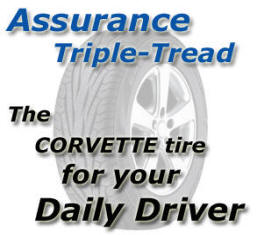
by Hib Halverson |
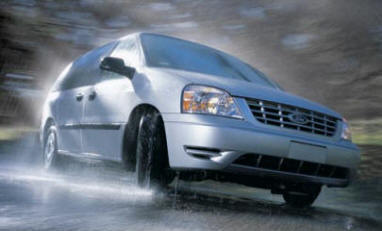
Image: Goodyear |
I don't use a Corvette
for daily transportation and I’ll bet many Idaho Corvette Page
readers are the same way. Most likely, a Vette is your recreation and
your daily driver might be a Ford minivan, a Buick Regal or a Toyota
Camry. Whatever you drive during the week still needs tires. Some of us
can be pretty thrifty when we buy tires for daily drivers, Why pay top
dollar to put rubber on an ordinary car, right? Well...maybe wrong.
|
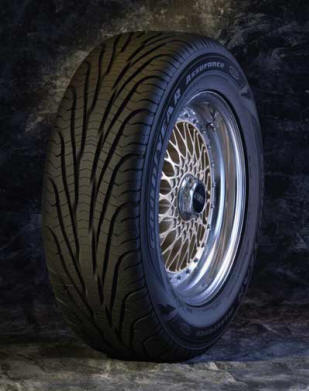 |
|
Goodyear's new Assurance. For a
daily-driver tire, it looks pretty sexy—somewhat like
the tires used on C5s and C6es and a lot like Goodyear's
benchmark, aftermarket ultra-performance tire the F1
GS-D3 Image: Aaron Vandersommers/Goodyear |
|
Statistics show
that you stand more of a chance of being in an automobile
accident during weekday driving within five miles of home than
you do driving your Corvette on weekend outings. Add inclement
weather to this equation and the stats stack-up even more
against you.
In many cases of
impending traffic collision, an emergency evasive maneuver, such
as swerving around another errant driver who's cut you off or
using full ABS braking to get stopped before hitting someone who
runs a red light in front of you can make the difference between
wrecking and driving on with nothing more than a pumping heart.
Traction—regardless of road conditions—is what you need to
maintain control of the vehicle in situations like that and how
much traction you have is greatly influenced your tires, a fact
which may give pause to some who believe buying cheap tires for
everyday, high-risk driving is a smart thing to do.
To date, my tire
tests have been of ultra-performance radials on Corvettes and
other performance cars or off-road tires on trucks and SUVs,
however, I became curious about tires on passenger sedans when
my fiance, the Fairest Sandra the Red, needed new tires on her
1996 Toyota Camry. |
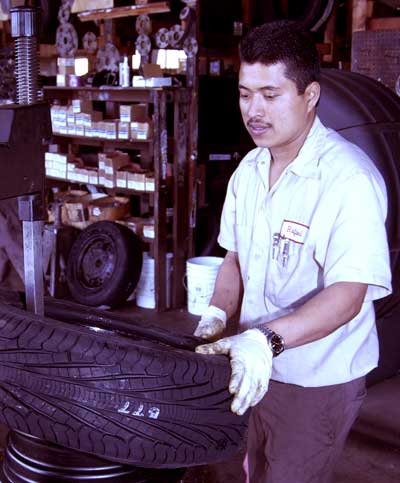 |
|
Mounting and balancing tires on daily
drivers demands much of the same care used to put them
on Corvettes. While this Camry has steel wheels, today,
many daily drivers have aluminum wheels so modern,
"wheel-friendly" tire mounting equipment is advised.
Image: author. |
|
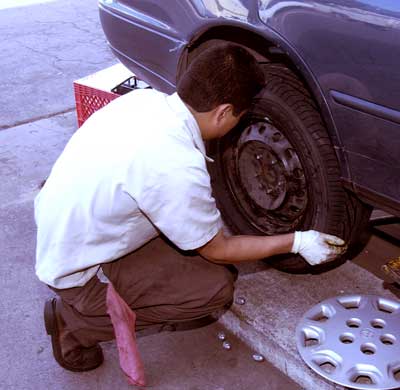 |
|
With any car, care must be used in
installing tire/wheel combos. Our Camry has steel wheels
and, with them, many technicians use impact wrenches to
tighten the wheel nuts. This is not recommended for
aluminum wheels and can be iffy for steel wheels, if the
impact gun is not adjusted properly. One of the causes
of warped brake rotors is overtightened wheel nuts. When
impact guns are used, they must be adjusted not to
overtorque the nuts and should be used to tighten in a
star pattern. Image: author |
|
| I
decided to try a set of Goodyear Assurance "TripleTreds" on her
car. Assurance is Goodyear’s premium, broad-market, replacement
tire. While it commands more than an entry-level price, the cost
doesn't seem out of line with similar products from other major
tire companies, as I learned in talking with Goodyear dealer,
Tucker Tire Sales in Azusa, California.
In April of 2004,
the Assurance replaced Goodyear's previous, premium tire, the
Aquatred 3. I asked why, after marketing Aquatred through three
product life-cycles, the Akron, Ohio company, which is the
world's largest tire maker, discontinued a name which was
familiar to consumers. Goodyear's PR Manager, Jim Davis, told me
that, because some customers identified Aquatred as a rain tire,
the company believed, if it changed the name, sales of its
high-end, broad-market products would improve in areas where
regular or significant wet weather was unusual. |
|
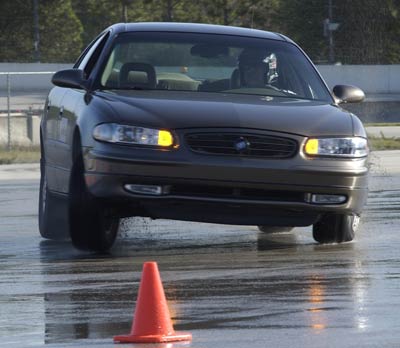 |
|
The author, caught by photographer, Aaron
Vandersommers, at a tire test in Florida in early
February of 2004. Looking at the car's lack of roll
stiffness, clearly, Buicks are not great slalom cars but
they are very typical of daily driver sedans.
Image: Goodyear/Aaron Vandersommers. |
|
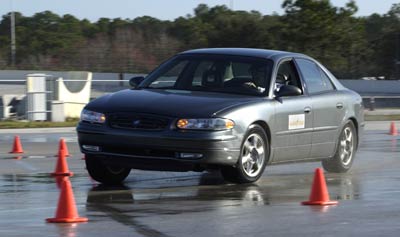 |
|
The tires being compared were the
Michelin HydroEdge and the Assurance. Image:
Goodyear/Aaron Vandersommers. |
|
|
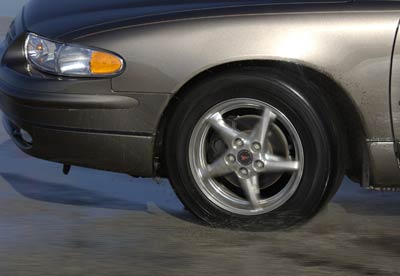 |
|
One reason the Assurance works really
well during emergency evasive maneuvers on wet surfaces
is the TripleTred Technology. The tire's Wet Zone,
channels water out and away from the contact patch and
the Dry Zone offers high lateral grip and improved
steering response. Image: Goodyear/Aaron Vandersommers. |
|
|
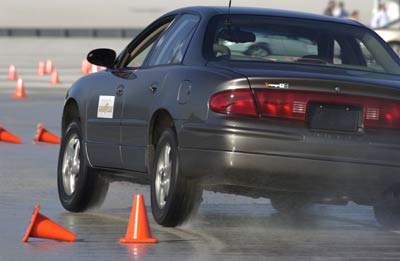 |
|
The autocross environment is a reasonable
test of a tire's ability to handle well during
low-speed, emergency evasive maneuvering on the street.
In the Buick shod with Assurance, the Author was
incrementally quicker on this slalom course than he was
in the same type of car fitted with Michelins.
Image: Goodyear/Aaron Vandersommers. |
|
Goodyear claims Assurance's wet-handling capability carries on
where Aquatred left off. That belief is supported by wet driving
comparison tests between it, the previous Aquatred and tires
made by competitors which I conducted in a test track
environment in Florida when I attended the tire's media launch
in early 2004.
Goodyear's
research, also, shows many of its customers still want good, wet
traction and hydroplaning resistance, so the "rain tire" issue
remains important, however, this new tire, through its so-called
"Triple Tread Technology", is also better on snow and ice and
has improved dry handling without compromising its capabilities
in the wet. I guess you could say this new tire is an
"any-weather" tire, rather than just a wet weather tire.
|
|
One Tire which is
Three Tires.
What is "TripleTred
Technology"? This version of Assurance (there is another, less-expensive
iteration called "ComforTred") has three "zones" spanning its tread
width, each having specific tread configuration and compounding which
Goodyear says enhance the tire's traction on different surfaces.
At the center, is
the "Ice Zone". Its key features are an interlocking tread and a
tread compound which has a mix of ground pumice and glass fibers
blended into it. The pumice gives the surface of the tread a
rough, texture. As the tire wears, the grit works out of the
tread compound leaving tiny cavities. The very thin layer of
water which covers ice when the temperature is above or near
freezing, migrates into these cavities allowing the tread to
better contact the ice. In addition, the cavities serve as
"traction edges" which further increase grip. The tiny glass
fibers protrude from the rubber, making a sort of "stubble"
which "digs into" the ice, aiding traction even more. |
|
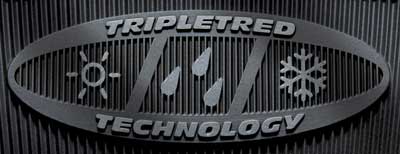 |
|
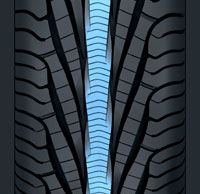 |
|
Assurance's Ice Zone. The interlocking
tread is pretty obvious. What's not is the special tread
compound which contains pumice and glass fibers. Image:
Goodyear. |
|
|
On either side of this Ice Zone are "Water Zones," the design of
which is a little more traditional. Influenced by the tread
configurations of some of Goodyear's Ultra-Performance tires,
such as the F1 GS-D3, the F1 GS EMT (O.E. on C5) or the F1 GS
EMT-2 (O.E. on C6), the Assurance Water Zone consists of, so
Goodyear says, "...deeply-carved Aquachutes..." which
force water away from the tread as it rolls on wet surfaces.
This water-channelling action has been a key feature of
Goodyear's racing rain tires and performance street tires for
more than 20 years. Proof that racing technology improves tires
we use on Toyota Camrys and other daily drivers is that kind of
special tread grooving has been common on Goodyear's up-level,
broad market tires for more than ten years and, also, has been
used by several, other tire companies |
|
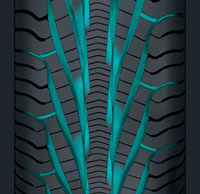 |
|
The Wet Zones work like the tread on
Goodyear's benchmark F1 GS-D3 to force water out and
away from the contact patch.
Image: Goodyear. |
|
|
The outside edges of Assurance are (what else?) Dry Zones which
feature reinforced shoulders for better dry traction during
aggressive maneuvering around curves, potholes, unexpected road
debris or stupid drivers cutting in front of you. In addition,
Assurance is the only broad-market Goodyear to use a derivative
of the tread compound on the F1 Supercar (on 01-04 Z06es) and
F1 Supercar EMT tires (on '05 Z51s and which will be on 06
Z06es). Lastly, the mold shape of the Assurance is taken from
Goodyear's ultra-performance tires and is particularly obvious
when looking at the edges of this new tire. |
|
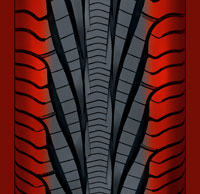 |
|
The Dry Zones have a reinforced shoulder
and use a tread compound derived from that on Goodyear's
F1 Supercar tires used on C5 and C6 Z06es. Image:
Goodyear. |
|
|
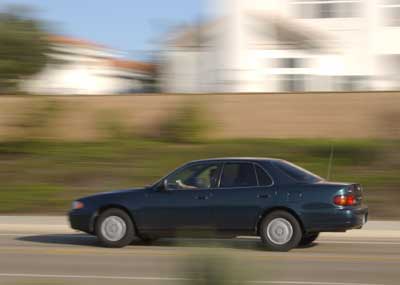 |
|
Our
Assurance-shod Toyota Camry "at speed". Image: Author. |
|
Ah....quiet.
Based on several months of subjective testing with Sandy's Camry
this past winter, I think the Assurance, is a pretty darn good
all-weather tire, however, the first thing I noticed after I
installed them and went for a drive was nothing related to
handling though it does relate to technology transfer from
ultra-performance tires which I spoke about earlier. It was
immediately obvious that this Assurance is noticeably quieter
than the tires we replaced, a set of three-year old Aquatreds
The owner of the
car, Sandra the Red, is pretty-much a layperson when it comes to
subjectively analyzing tire noise, but she, also, noticed this
difference right away, terming the new tires, "...a lot
quieter." Because the noise difference between the old Aquatred
and the new Assurance was so significant, I decided to
investigate a bit with an interview of three Goodyear engineers,
Sam Landers, Walt Allen and Karl Sundkvist. |
"One of our objectives
was to reduce noise—this needed to be a quiet tire, as well as having
ultimate traction,"
Sam Landers told the Idaho Corvette Page. "That came from a
combination of fine-tuning of the tread design and the tire structure."
More specifically, Landers said that a key enabler of this reduced noise
was "...a pitch sequence which is the next generation in that
technology and came from the (Eagle) F1 program."
|
Use the term
"pitch sequence" and you'll be talking like a tire deep-geek.
Imagine a tire tread laid out flat. The tread blocks are such
that, when the tire rolls, their length and spacing emit sound
of a certain pitch. If the this length and spacing, or
"sequence", is the same; the tire makes a lot of noise of a
certain frequency or pitch and that noise will be very
noticeable. Conversely, if the pitch spacing is varied, by
making the blocks and the spaces between them different lengths,
the sound has a variety of pitches and sounds more like "white"
noise rather than a whine, hum or rumble.
Sophisticated
computer modeling and analysis are used to design this pitch
sequencing and are backed up with laboratory and proving ground
testing. The result is tire noise which is more like "...a
waterfall or background sound which can have more (acoustic)
energy," Goodyear noise expert, Karl Sundkvist elaborated,
"but be less annoying than a whine with the same amount of
energy. The pitch sequence was designed specifically for
(the Assurance TripleTred). Because the (latest
ultra-performance tread designs) are newer, we studied them
more and applied some research techniques to look at what was
causing the noise. From that we learned and improved the
Assurance design as we were developing it." |
|
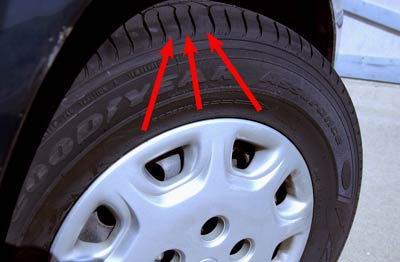 |
|
This is one of the 195/70R14s on the
Camry. Look close at the arrows which show the varied
pitch sequence of the tread blocks. Each of those three
blocks is a different length. That reduces annoying tire
noise. Image: Author. |
|
"Contrast
the TripleTred vs. the Aquatred 3,"
Walt Allen stated, "and you'll notice there are a number of
construction features that are different and play a part in making the
tire quiet. The hard apex affects that. Also, the belt wire is larger
and this tire has an overlay which the Aquatred 3 did not have."
Sam Landers added, "We
were trying to get that tread area, the foundation of the tire, as stiff
and as stable as possible. That improves handling, steering response and
it also improves the noise. If you make the tire structure stiffer the
tire vibrates differently—has a different resonance. There isn't as much
noise transmitted. You have two steel belts which are at slight
angles—five degrees or around there—relative to the tire centerline. The
overlay is at zero degrees. It's wound circumferentially around the
tire. The belts are steel and the overlay is nylon. It acts as a
restrictor layer which is normally put on high-speed/high-performance
tires. It's stiffens the crown area, reducing noise, and makes the tire
more responsive to steering input."
|
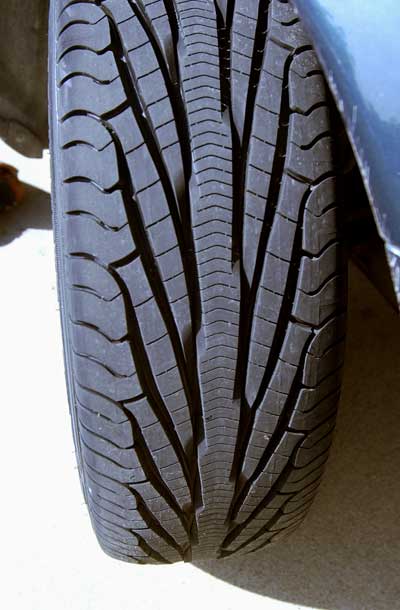 |
|
The business end of the
Assurance showing the F1 GS-D3-like tread. Under that
tread is the nylon overlay which stabilizes the the tire
making it more rigid and less likely to transmit noise
of the pitch that is annoying. Image: Author. |
|
Driving
Assurance.
It’s pointless to
drive a base-level, Toyota Camry to the same limits to which I’d
test a set of performance tires like I’ve reviewed elsewhere on
Idavette, but in brisk driving around town, the Camry
felt more responsive to steering input and had more lateral grip
in turns than it did when shod with Aquatred 3s. These new tires
noticeably improved the car’s dry handling because some their
Eagle F1-derived features are valuable in many ordinary driving
situations.
Where Assurance,
also, shines is in bad weather. The winter of 2005 brought a
deluge of rainfall to Southern California–so much rain that
eight-months into the July-to-June, "rain year", we'd had almost
three times the rain than we get in an average year and second
wettest year on record. In late-February, the third major winter
storm blew in off the Pacific bringing 15-in. of rain to certain
areas of Southern California. My fiance lives in the seaside
town of Goleta about 10 miles west of Santa Barbara. When it
rains in Southern California, Goleta can get drenched and this
storm was a soaker. What better time to go wet test these new
tires?
I jumped on US
101, headed west, along the coast, towards Gaviota and cruised
at the speed limit for a while. In spite of a constant,
moderate-to-heavy rain, the car felt like the road was hardly
wet. Then, I decided to take it up to 80. At that speed, the car
still felt pretty good. The tires were doing an excellent job
of channeling water away from the contact patch. While I felt
the car slow—then I just gave it more gas—when the strongest
downpours put a thick layer of rainwater on the road; I felt no
hydroplaning. Even through shallow standing water in some spots
or drainage flows across the highway, these tires seemed to cut
through the water, and stick to the road like glue. In fact, I
became more concerned about the Camry’s overworked windshield
wipers, which were making a furious attempt to keep the
windshield partially clear, than the tires hydroplaning.
|
|
The storm became
a pounding deluge. Offshore, to the south, I saw lightning
strikes on the water. Wind buffeted the car back-and-forth
across lanes. Rain and even a little hail rattled on the
windshield and the top. This became more a loosing battle for
the wipers against an ever-increasing torrent of rain and, with
visibility getting pretty bad so I lifted bit and reestablished
a 60-mph pace.
I reached Gaviota,
turned around and, on the drive back to Goleta, continued severe
weather kept me at about 60 because of the visibility. As I
rolled along with the wipers on high, I thought about these
tires. Goodyear backs the Assurance with an 80,000 mile tread
life, limited warranty and a 30-day, no obligation "trial
period".
This warranty,
the trial period and that Assurance is seemingly an anyweather
tire, seems to appeal to consumers buying premium, broad-market,
replacement tires. Supporting that belief is that Goodyear's Jim
Davis stated in a follow-up interview that actual sales of the
Assurance, since it was launched in the early Spring of '04, are
twice what the company projected. Goodyear's dealers can get
enough of them and Goodyear's plants are working overtime to
meet demand.
While the
TripleTreds didn’t turn this Camry into a Corvette—although the
weather tried to turn it into a submarine—it sure did improve
its handling in the wet and the dry such that anyone driving
feels more confident. Plus—they are quieter.
If you've got a
passenger sedan as a daily driver, you're going to be safer if
you have the Goodyear Assurance with TripleTred Technology.
|
|
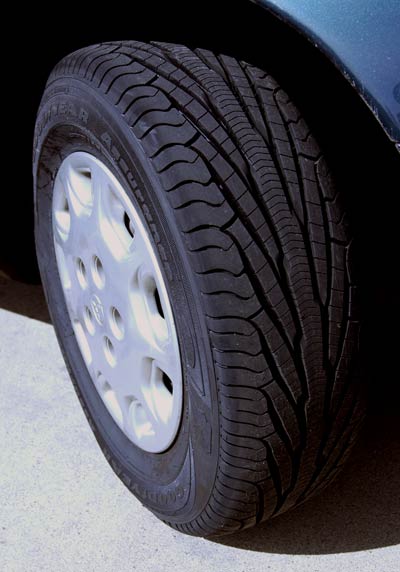 |
|
Besides having a tread that works quite
well on any road condition, dry, wet or frozen, as we
said before; the Assurance looks really sexy, with it's
deep, angled, Aquachutes and performance tire, mold
shape. Goodyear tells us, this is one reason for its big
sales success. Image: Author. |
|
|
















